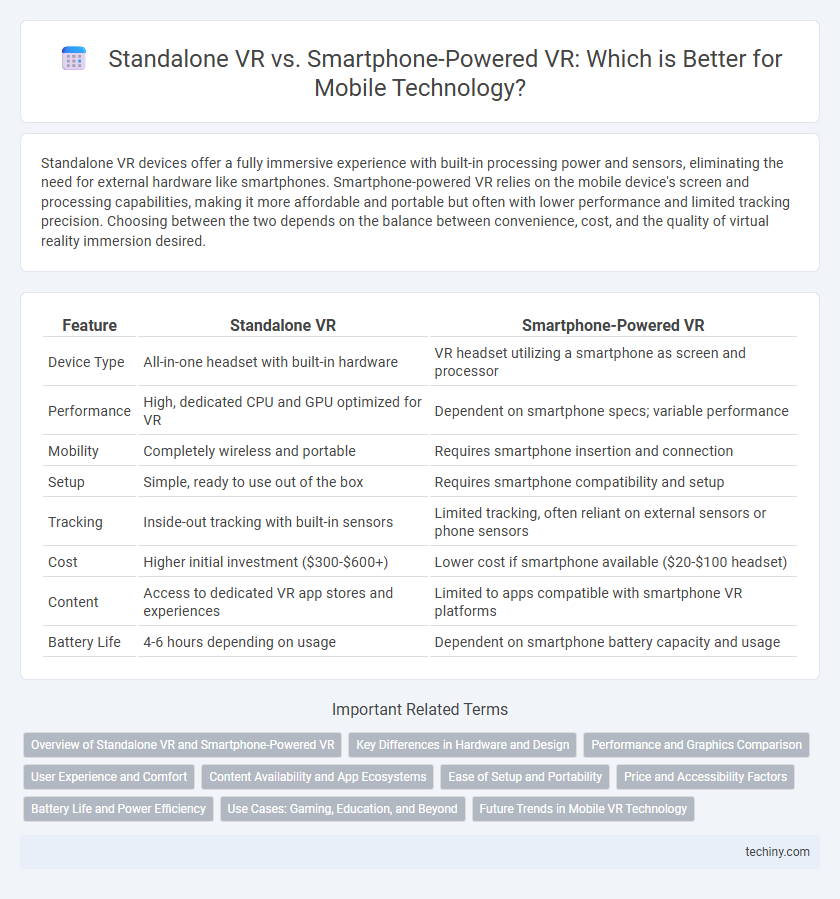Standalone VR devices offer a fully immersive experience with built-in processing power and sensors, eliminating the need for external hardware like smartphones. Smartphone-powered VR relies on the mobile device's screen and processing capabilities, making it more affordable and portable but often with lower performance and limited tracking precision. Choosing between the two depends on the balance between convenience, cost, and the quality of virtual reality immersion desired.
Table of Comparison
| Feature | Standalone VR | Smartphone-Powered VR |
|---|---|---|
| Device Type | All-in-one headset with built-in hardware | VR headset utilizing a smartphone as screen and processor |
| Performance | High, dedicated CPU and GPU optimized for VR | Dependent on smartphone specs; variable performance |
| Mobility | Completely wireless and portable | Requires smartphone insertion and connection |
| Setup | Simple, ready to use out of the box | Requires smartphone compatibility and setup |
| Tracking | Inside-out tracking with built-in sensors | Limited tracking, often reliant on external sensors or phone sensors |
| Cost | Higher initial investment ($300-$600+) | Lower cost if smartphone available ($20-$100 headset) |
| Content | Access to dedicated VR app stores and experiences | Limited to apps compatible with smartphone VR platforms |
| Battery Life | 4-6 hours depending on usage | Dependent on smartphone battery capacity and usage |
Overview of Standalone VR and Smartphone-Powered VR
Standalone VR headsets operate independently without requiring external devices, offering built-in processing power, integrated sensors, and wireless freedom for immersive virtual experiences. Smartphone-powered VR relies on a mobile device inserted into the headset, leveraging the phone's display, processor, and sensors, making it a more affordable and accessible option but with limited performance and tethered interaction. Key differences include standalone VR's enhanced graphics, tracking capabilities, and standalone app ecosystems versus the dependency on smartphone hardware and battery life in smartphone-powered VR.
Key Differences in Hardware and Design
Standalone VR headsets feature integrated processors, batteries, and sensors, enabling wireless and untethered experiences with dedicated high-performance hardware optimized for VR applications. Smartphone-powered VR relies on a compatible smartphone inserted into the headset, utilizing the phone's display, sensors, and processing power, resulting in a more affordable but less immersive experience due to hardware limitations. Design differences include standalone VR units having ergonomically balanced construction with built-in controls, while smartphone VR headsets are typically lighter but depend heavily on the smartphone's specifications and battery life.
Performance and Graphics Comparison
Standalone VR headsets offer superior performance and graphics compared to smartphone-powered VR, thanks to dedicated processors and optimized hardware designed for immersive experiences. These devices support higher resolution displays, faster refresh rates, and advanced tracking systems that reduce latency and motion blur. Smartphone-powered VR relies on the mobile device's capabilities, resulting in limited graphical fidelity and slower processing, which can impact overall visual quality and responsiveness.
User Experience and Comfort
Standalone VR headsets offer a more immersive user experience with higher processing power and precise motion tracking compared to smartphone-powered VR, reducing latency and enhancing visual fidelity. They provide greater comfort through ergonomic design and balanced weight distribution, minimizing strain during extended use. Smartphone-powered VR, while more affordable, often suffers from limited interactivity and bulkier setups that can cause discomfort and detract from immersive engagement.
Content Availability and App Ecosystems
Standalone VR headsets offer a robust app ecosystem with exclusive titles optimized for immersive experiences, supported by platforms like Oculus Quest Store and Viveport. Smartphone-powered VR relies on mobile apps available through Google Play or the Apple App Store, which limits content variety and quality due to hardware constraints. The standalone devices provide richer, more diverse content libraries that benefit from dedicated development and seamless software updates.
Ease of Setup and Portability
Standalone VR headsets offer superior ease of setup with all-in-one functionality, eliminating the need for external devices or cables. Their lightweight design and compact form factor enhance portability, allowing users to enjoy immersive experiences anytime, anywhere. In contrast, smartphone-powered VR depends on compatible smartphones and additional peripherals, making the setup more cumbersome and less convenient for on-the-go use.
Price and Accessibility Factors
Standalone VR headsets typically cost between $300 and $500, providing a self-contained experience without the need for external devices, making them more accessible for users without high-end smartphones. Smartphone-powered VR options are generally more affordable, often under $100, but their performance and compatibility depend heavily on the smartphone model and specifications. The price advantage of smartphone VR is offset by limited accessibility due to device restrictions, whereas standalone VR offers broader usability with integrated hardware.
Battery Life and Power Efficiency
Standalone VR headsets feature integrated batteries optimized for extended usage, offering longer playtime compared to smartphone-powered VR, which drains phone batteries rapidly due to intensive processing demands. Power efficiency in standalone devices is enhanced by dedicated hardware tailored for VR applications, reducing overall energy consumption. Smartphone-powered VR relies heavily on the phone's general-purpose processor, leading to faster battery depletion and potential overheating.
Use Cases: Gaming, Education, and Beyond
Standalone VR headsets offer immersive gaming experiences with higher graphics performance and greater freedom of movement compared to smartphone-powered VR, which relies on mobile devices with limited processing power. In education, standalone VR enables interactive simulations and virtual classrooms without tethering, while smartphone-powered VR suits casual learning apps requiring budget-friendly accessibility. Beyond gaming and education, standalone VR supports advanced applications like virtual tourism and professional training, whereas smartphone VR remains ideal for lightweight, on-the-go experiences.
Future Trends in Mobile VR Technology
Standalone VR headsets are poised to dominate future mobile VR technology due to their integrated processing power, eliminating the need for external devices like smartphones. Advances in wireless connectivity, such as 5G and Wi-Fi 6, will enhance standalone VR experiences by enabling seamless streaming and lower latency. Expect improvements in battery life, display resolution, and AI-driven enhancements to drive immersive and accessible mobile VR applications.
Standalone VR vs smartphone-powered VR Infographic

 techiny.com
techiny.com